Voting is an essential element of India’s democratic makeup. It is a fundamental right of all citizens of India who are 18 years and above to cast their vote in order to choose their representative during the election period. To participate in the electoral process, it is necessary to register yourself as a voter with the Election Commission of India (ECI) and get a Voter ID card.
Through this comprehensive blog, we’ll understand the step-by-step process to apply for Voter ID online registration, along with the eligibility criteria, documents required, verification process, and details about forms associated with it.
Who Can Apply for Voter ID Online Registration?
- Indian Citizenship
- The person must be a citizen of India.
- Age Requirement
- The individual must be at least 18 years of age on the qualifying date, typically January 1st of the year in which the voter list is prepared.
- Permanent Residence
- The individual should have a permanent address within India. This address will be used to assign the person to a specific polling booth.
Ineligibility for Online Voter Registration
Following individuals are not eligible to register as voters in India:
- NRIs who have acquired citizenship of another country are ineligible to vote in India, as dual citizenship is not permitted.
- Persons who have been declared by a competent court as having an unsound mind are disqualified from voter registration.
- Those who have been convicted of specific serious offenses and are barred by the law from voting are not eligible to register.
- Individuals currently serving a sentence of imprisonment for an offense are also not eligible for voter registration during the period of their incarceration.
Documents Required for Online Voter Registration
For Address Proof:
- Utility Bills: Recent utility bills, such as water, electricity, or gas bills (not older than one year from the date of submission).
- Bank Passbook: The current passbook from a public sector bank, a scheduled bank, or a post office, showing your address.
- Registered Rental or Lease Agreement: If you are a tenant, a registered rental or lease agreement that clearly mentions your address.
- Registered Sale Deed: In case you own property, a registered sale deed serves as proof of address for that property.
- Aadhaar Card: Includes your photograph and address.
- Indian Passport: Your Indian passport, containing your photograph and address details.
- Land Ownership Records: Documents from the revenue department that confirm land ownership, including the Kisan Bahi, can be submitted as address proof.
For Proof of Date of Birth:
- Educational Certificates: Certificates from class X or XII issued by the CBSE, ICSE, or State Education Boards, which include your date of birth.
- Birth Certificate: A birth certificate issued by a competent local body, municipal authority, or the Registrar of Births and Deaths.
- Driving License: A driving license, which includes your date of birth.
- Aadhaar Card: The Aadhaar card also serves as proof of date of birth.
- PAN Card: Your Permanent Account Number (PAN) card, which includes your date of birth.
- Indian Passport: The Indian passport, which records your date of birth.
- You will need to submit two recent passport-sized photographs. Ensure that these photos were taken within six months prior to the submission date.
How to Register for a New Election Card Online?
Follow the step-by-step instructions to proceed with creating new voter id registration:
Step 1: Go to https://voters.eci.gov.in/
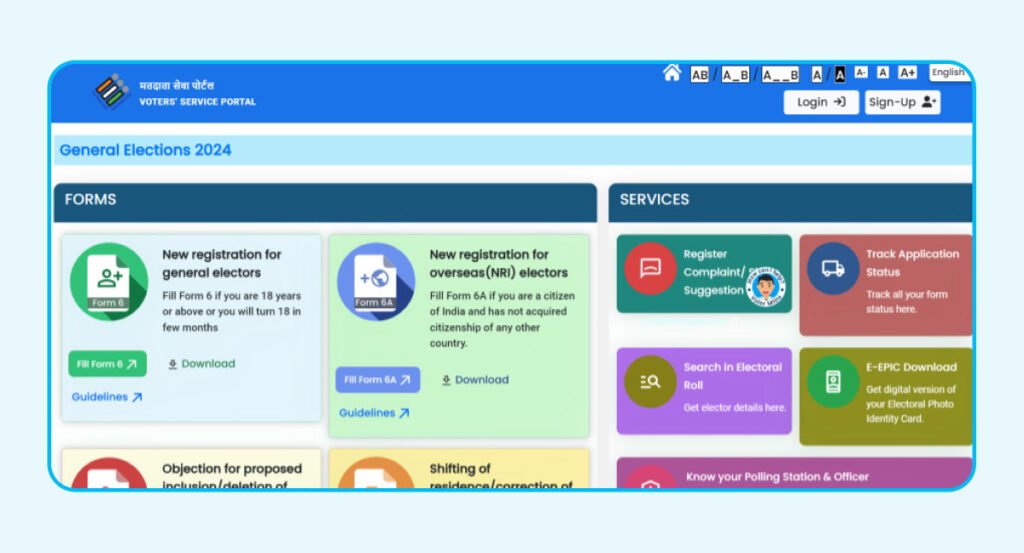
Step 2: Click on ‘Sign-Up’ at the top corner on the right-hand side of the page. \

Step 3: Enter your mobile number, email address (optional) and captcha as mentioned. Click ‘continue’.
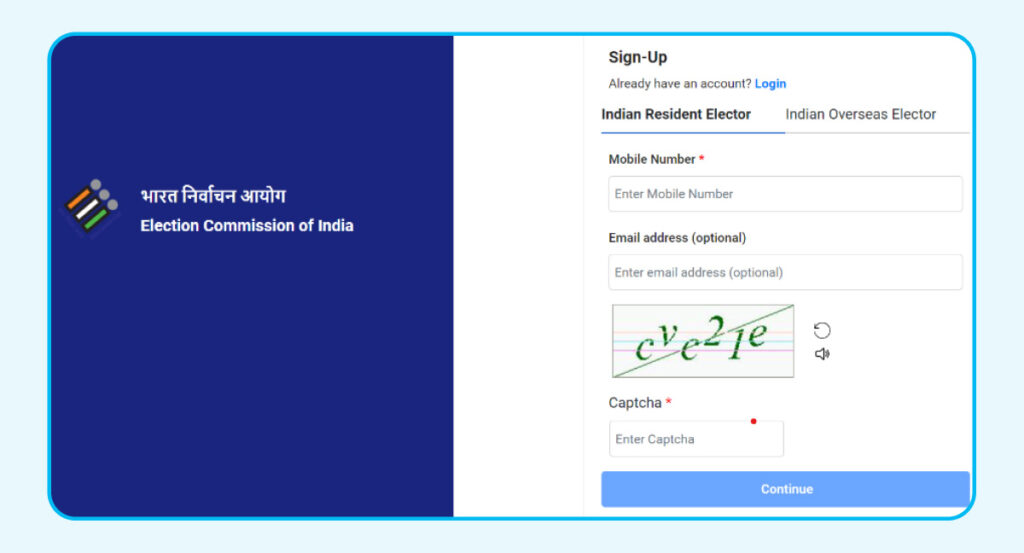
Step 4: Enter your first and last name. Set a password and confirm your password. Click ‘request OTP’ option.
Step 5: Enter the OTP received on your mobile number and email id. Click ‘verify’ to continue.
Step 6: Now you have successfully registered. You can return to the login page to continue with your new credentials.
Step 7: On the Login page, enter your registered mobile number, password and captcha code.
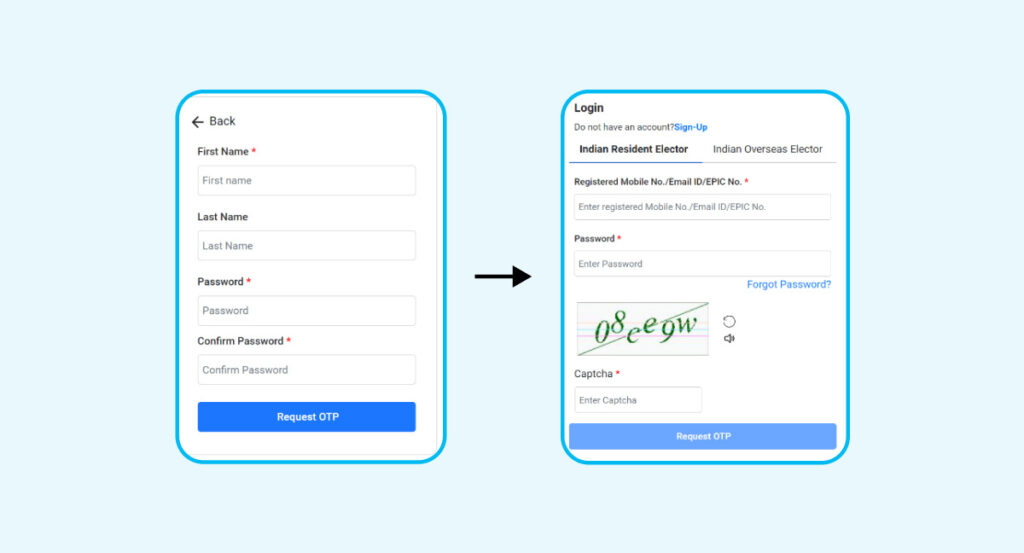
Step 8: enter the OTP received on your mobile number and click ‘Verify & Login’.
Step 9: On the homepage, locate the section with title ‘new registration for general electors’. Click on ‘Fill Form 6’.
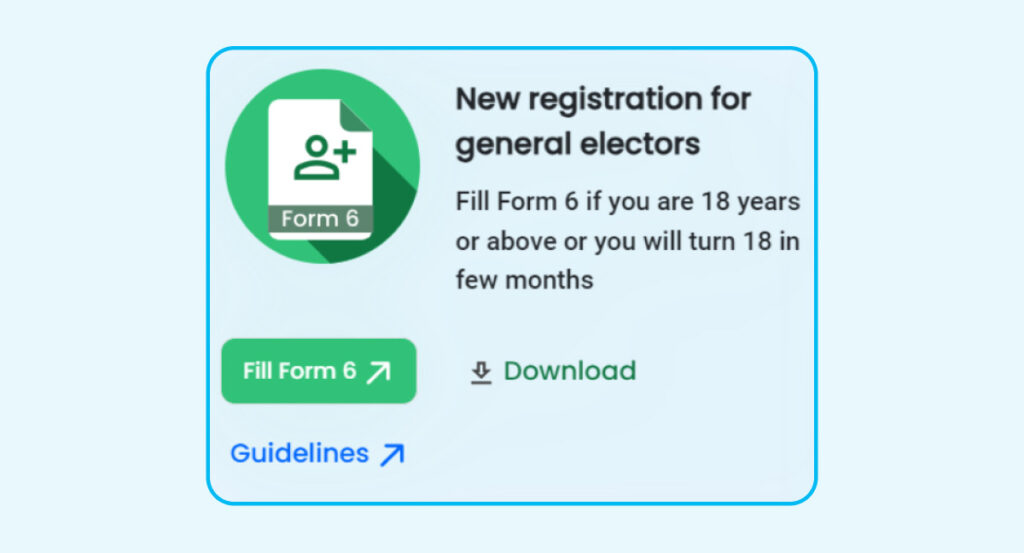
Step 10: Fill all particulars of Form 6 including ‘select state, district & AC’, ‘personal details’, ‘relatives details’, ‘contact details’, ‘aadhar details’, ‘gender’, ‘date of birth details’ and ‘present address details’. Upload the necessary documents wherever required.
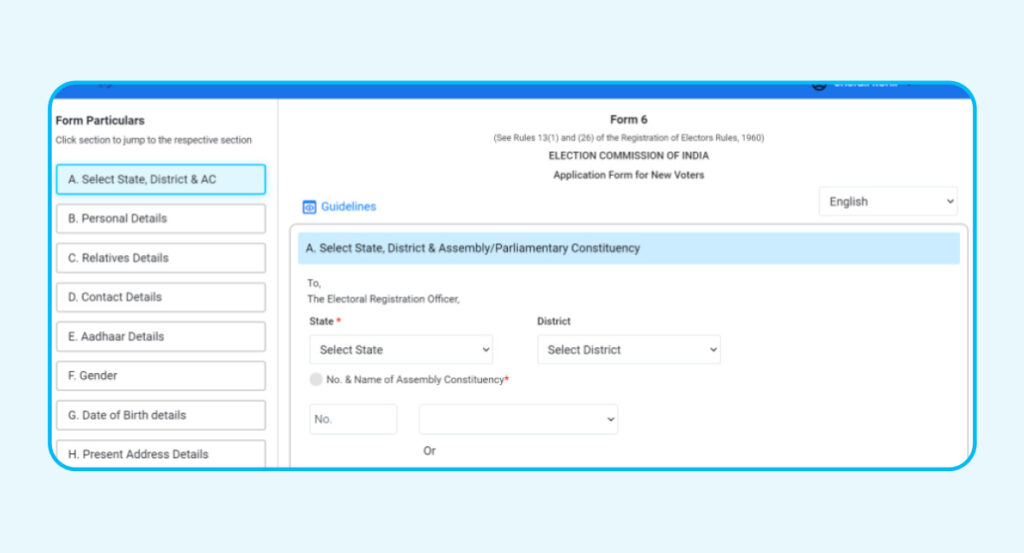
Step 11: Carefully check all the details and click the ‘Submit’ button.
What is the Verification Process for Voter ID Registration?
- Verification by Booth Level Officer (BLO):
- After you submit Form 6, either online or offline, a Booth Level Officer (BLO) will verify your details.
- The BLO checks the address in your proof of address document, making sure it meets the Election Commission’s standards and that the document is genuine.
If There Are Issues:
- If any inconsistencies or problems are found by BLO during verification, your application will be rejected, and you won’t receive a Voter ID.
- You’ll need to submit a new application to start the process again.
If everything is correct:
- If there are no issues during verification, your application will be approved, and you’ll be eligible to receive a Voter ID.
- The Voter ID is usually delivered to the address you provided or via email within 15 to 21 days after verification is complete.
How to Check Voter ID Online Registration Status Online?
Follow the given steps to check your online Voter ID registration status online:
Step 1: Go to https://voters.eci.gov.in/
Step 2: Click on ‘Login’ at the top right corner of the homepage.
Step 3: Enter your registered mobile number, password, and the captcha code, then click on ‘Request OTP’ (One-Time Password).
Step 4: After receiving the OTP on your mobile, enter it and click ‘Verify and Login’ to access your account.
Step 5: Once logged in, click on the ‘Track Application Status’ tab.
Step 6: Enter your reference ID, select your state, and then click the ‘Submit’ button. Your voter registration status will be displayed on the screen.
Note: Reference ID is a unique number assigned to your voter registration online application form. You will find this number on the acknowledgement slip provided when you submit Form 6 for voter registration.
Another way to check status is to visit your local Electoral Registration Officer (ERO). By providing your name, date of birth, and address, the ERO can check and inform you of your voter registration status.
What Online Application Forms are Required for Voter ID Registration?
- Form 6: For registering to vote if you are 18 years old or will be turning 18 within the next few months.
- Form 6A: For new voter registration as an overseas (NRI) elector, you need to fill Form 6A if you are an Indian citizen and have not obtained citizenship in any other country.
- Form 6B: This form is used to link aadhaar card with Voter ID.
- Form 7: Fill form 7 to get name removed from the existing electoral roll.
- Form 8: To modify, add, or correct entries in your Voter ID, or for marking as PwD, individuals must complete this form.
- Form M: This form is for migrant electors from Kashmir who wish to vote at one of the special polling stations located in Delhi, Jammu, or Udhampur.
- Form 12B: This form is for migrant electors from Kashmir who wish to cast their vote through a postal ballot.
Things to Avoid While Registering for Voter ID Online
- Make sure to use the correct form for your Voter ID registration from the forms provided: Form 6, 6A, 6B, 7, 8, M, 12B. Ensure you read guidelines for each form carefully before filling.
- Ensure you submit all required documents carefully along with your registration to verify that your details are accurate.
- Double-check the form for any errors, such as spelling mistakes, as these will appear on your Voter ID.
Disclaimer: This blog is written to make it easy for readers to understand complicated processes. Some information and screenshots may be outdated as government processes can change anytime without notification. However, we try our best to keep our blogs updated and relevant.



